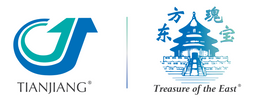Production Processes
From raw material to final product, Tianjiang’s state of the art full spectrum extraction methods preserve flavor, increase solubility, and deliver consistently high-quality herbal extracts. Our cutting edge production technology is fully automated and backed by 30 patents across the manufacturing process. Of all the innovations, our dry granulation process is particularly remarkable - read on to learn more.
1. Identification. Following procurement of high-quality raw herbs, the first step of the production process is inspection and identification. Tianjiang uses hundreds of thin-layer chromatography (TLC) botanical identification standards in order to verify authenticity with absolute certainty. Each batch of incoming materials is tested prior to acceptance into the production process.
2. Pao Zhi (Traditional Processing). Once procured and authenticated, raw herbs are cleaned and prepared according to traditional Pao Zhi practices, the Chinese Pharmacopeia, and internal research on optimal production parameters (described in more detail here). The various Pao Zhi processing methods employed include soaking, steaming, stir-frying, germinating, fermenting, toasting, freezing, and more.

3. Water-Based Extraction. In adherence with traditional methods of decoction, our full-spectrum extraction process uses only purified water. We employ a two-step extraction that captures botanical constituents and essential oils without the use of solvents like alcohol, acetone, or hexane. The extraction process is conducted according to experimentally derived production parameters that are specific to the plant species and the plant part (root, rhizome, flower, fruit, seed, bark, entire plant, etc.). Fully automated production equipment allows the temperature, pressure and other parameters of the extraction process to be precisely controlled. Essential oils are captured for reintroduction prior to the granulation step. Read more about full-spectrum extraction here.
4. Filtration and Concentration. Once extracted and filtered, a low-temperature vacuum concentration method is employed to rapidly concentrate the herbs. Extracts held at a temperature range of 40-60°C while placed under vacuum, which is then followed by a cryo-concentration process. Quality control personnel inspect all materials before they are permitted to move forward.
5. Spray Drying. Tianjiang’s advanced spray drying techniques dry the extracts instantly, preserving the active ingredients, and maintaining our high standards for freshness, color, texture, taste, and water content. Our technique employs high speed centrifugal atomizers to disperse the extract into tiny droplets that dry instantly when in contact with warm air. The temperature of the extract during the drying process remains low, which helps to preserve heat-sensitive extracts. A pneumatic conveying system promptly separates the extract from residual heat and moisture to prevent reabsorption or agglomeration. The product of this process is a pure extract with varying concentration ratios. For some products, this is the final stage of production while others will move on to granulation.
6. Re-introduction of Essential Oils. Essential oils are captured during the extraction process for reintroduction into the final product. To minimize evaporative losses of essential oils in the final product, liquid oils are solidified before being incorporated into the granules. Reintroduction of essential oils is a key part of ensuring that an extract maintains the raw material’s flavor and aroma as well as valuable biochemical components that may be otherwise lost.
7. Dry Granulation. Tianjiang uses a patented dry granulation process that mechanically forms granules at lower temperatures and with minimal excipients compared to standard wet spray techniques. The dry powder extract is mechanically compressed and formed into thin sheets, which are then broken into granules before being sieved and pressed again to form particles of uniform size. Granulation is entirely performed within an ISO Class 6 cleanroom environment. 
8. Laboratory Testing. Laboratory analysis with state of the art technology examines variables such as concentration ratio, solubility, bacterial contamination, heavy metal presence, pesticide residue, and aflatoxin. Tianjiang's world class laboratory uses modern analytical and testing instruments such as thin-layer chromatography (TLC), high-performance liquid chromatography (HPLC), gas chromatography (GC), inductively coupled plasma atomic emission spectroscopy (ICP-AES), and mass spectrometry. HPLC, GC, and mass spectrometry are used to evaluate the level of active chemical constituents in the herbal extract granules against Tianjiang's internal standards for 150 herbs. Certificates of Analysis are available for every batch. Read more about our laboratory testing HERE.
9. Packaging, Quality Control, and Distribution. Once the extracts have passed laboratory analysis and inspection, an automated bottling and packaging system completes the production process. Skilled quality control personnel, following all Chinese Pharmaceutical GMP requirements, oversee the process and perform final quality checks before the products are stored and distributed. 
Read more about laboratory testing of Treasure of the East herbs HERE.
